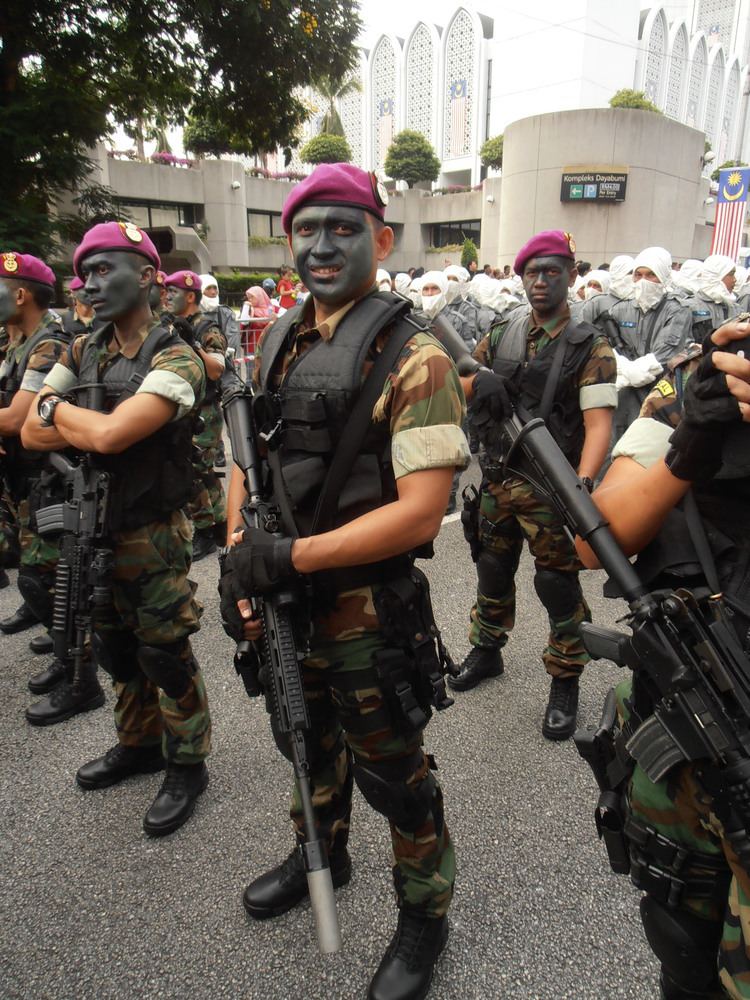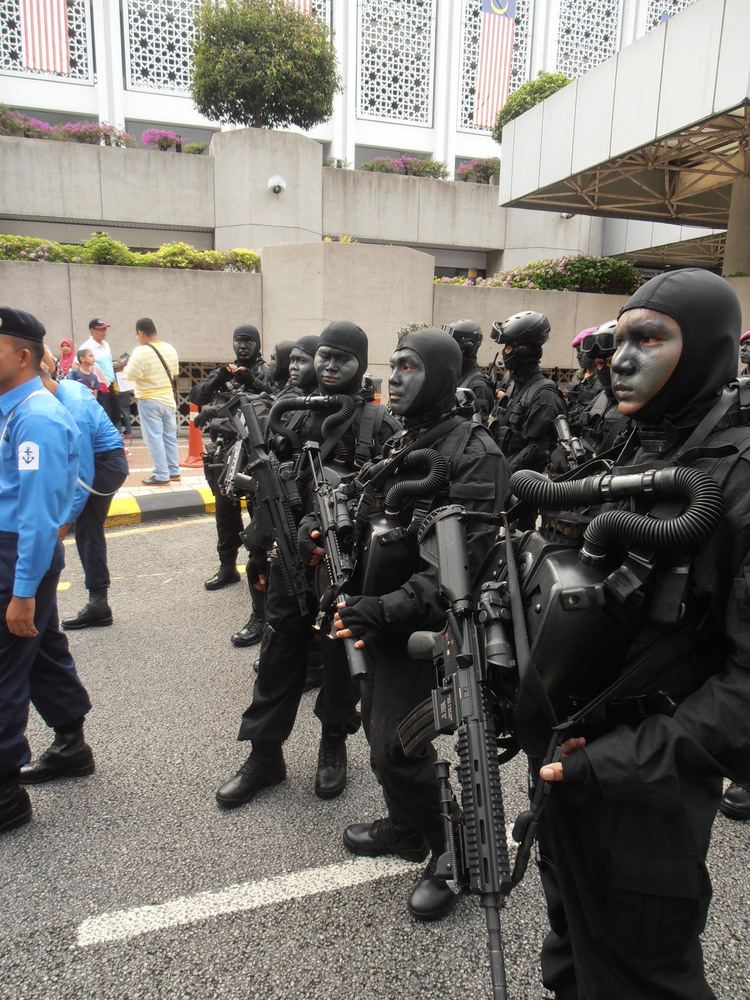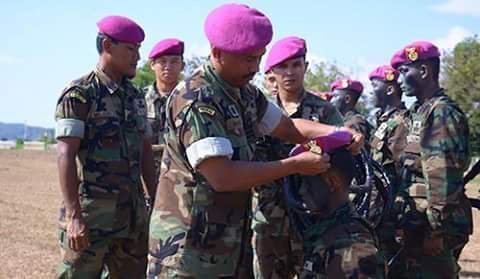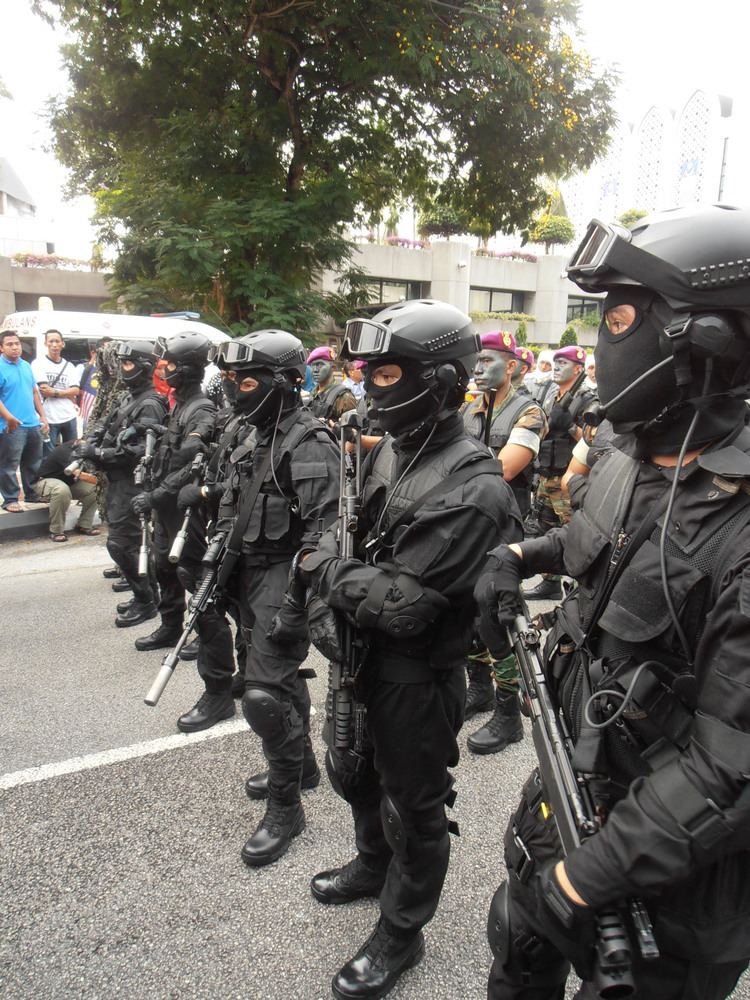Country Malaysia | Founded 1980 | |
 | ||
Active 1 October 1980 – present (36 years) Motto Sentiasa Terbaik; (English: Always The Best) Roles Counter-terrorism, Underwater Demolition Team | ||
Paskal lanclume mov pass
The Pasukan Khas Laut (English: Naval Special Warfare Forces, Jawi:ڤاسوكن خاص لاوت), commonly abbreviated PASKAL, is the principal special operations force of the Royal Malaysian Navy.
Contents
- Paskal lanclume mov pass
- History
- Initial training
- Exclusive Economic Zone
- Panglima Hitam
- Taiping Perak
- Kuala Selangor Selangor
- Jugra Selangor
- Muar Johore
- Segamat Johore
- Roles and responsibilities
- Selection and training
- Basic recruitment
- Career development
- ExpertiseSpecialist Course
- Naval Special Operations Units
- Structure
- Equipment
- Uniforms
- Night vision devices
- Accessories
- Helmets
- Thermal imaging common modules
- Various ground tactical
- Weaponry
- Bladed weapons
- Sidearms
- Shotguns
- Submachine guns
- Assault rifles and carbines
- Anti materiel rifles
- Designated marksman rifles
- Sniper rifles
- Machine guns
- Hand grenades
- Grenade launchers
- Others
- Vehicles
- Emblems and badges
- Notable PASKAL members
- Operations and covert actions
- Operation Dawn Ops Fajar
- Rescue operations of Zhenhua 4
- Rescue operation of MV Abul Kalam Azad
- MALCON ISAF
- Operation Dawn 8 Gulf of Aden
- Lahad Datu conflict
- MT Orkim Harmony hijacking
- References

PASKAL's task is to conduct small-unit maritime military operations that originate from, and return to a river, ocean, swamp, delta or coastline. PASKAL also perform unconventional warfare; guerrilla warfare; counter-guerrilla warfare; jungle warfare; counter-terrorism; close protection; hostage rescue and foreign internal defence.

Although PASKAL was created as a maritime counter-terrorism unit, it has become a multi-functional special operations unit with roles that include high-risk operations including direct action, special reconnaissance operations and other specialised missions.
PASKAL is an all-male force officially established on 1 October 1980, after a five-year setup period, with the purpose of enforcing Malaysia's Exclusive Economic Zone maritime claims through sea, air and land operations.

PASKAL personnel routinely serve and train with allied SOFs including the Indonesian Kopassus and Denjaka, Singaporean Naval Diving Unit and Thai Navy SEALs.

History

PASKAL had its origins in a perceived need for a security regiment trained in modern maritime operations. It main purpose was the protection of Malaysia's naval bases and national assets. (At that time, the RMN main base was known as KD Malaya (Kapal Diraja Malaya, His Majesty's Ship Malaya), formerly known as HMS Malaya before independence, in Woodlands, Singapore, which was later transferred to the new naval base in Lumut, Perak when it was completed in 1979.

The Security Regiment is largely composed of sailors responsible for the security of strategic sites such as bases and ammunition depots. When the main naval base at Lumut became available PASKAL headquarters was established there in 1981.
Initial training

Following the United Nations Convention on the Law of the Sea (UNCLOS) Malaysia was among the first nations to claim the right to extend maritime borders beyond the previous 12 (nautical) mile limit. The new unit received basic training at the Malaysian Army Grup Gerak Khas Special Warfare Training Center, Sungai Udang, Malacca.

In 1977, the first batch of 30 officers, led by Captain Sutarji Bin Kasmin (now Admiral, retired), was sent to Kota Pahlawan, Surabaya, Indonesia to receive jungle training delivered by Indonesian Navy KOPASKA. On their return the cadre were referred to as Navy Commandos.
To enhance and diversify their skill set they trained in Portsmouth, United Kingdom with UK Royal Marines Commandos and to California by US Navy SEALs. A few, including RMN senior officer, Lieutenant Commander Ahmad Ramli Kardi travelled on to Coronado, California and Norfolk, Virginia to receive additional training by the US Navy SEALs.
Exclusive Economic Zone
In April 1980, Malaysia declared that its EEZ reached up to 200 nautical miles from the coast as provided by the UNCLOS. This decision affected development plan as a naval fleet is directly responsible for controlling and protecting its national waters and has made Malaysia a maritime littoral nation of some 598,450 square kilometres (approximately 231060 square miles) including some four and a half thousand kilometres of coastline and over a thousand islands.
On 1 October 1982, PASKAL was officially established as the instrument used to enforce the Malaysian EEZ. In an effort to strengthen its claim over the Spratly Islands Waters (subject to overlapping claims by multiple countries) the National Security Council of Malaysia mandated PASKAL as Maritime Counter-Terrorism operatives in 1991.
Panglima Hitam
On 15 April 2009, PASKAL Team Command (PTC) was officially named KD Panglima Hitam in a ceremony held at the Royal Malaysian Navy HQ in Lumut, Perak by the King of Malaysia, Yang di-Pertuan Agong Tuanku Mizan Zainal Abidin to honour PASKAL's service.
KD Panglima Hitam translates into English as HMS Black Knight, inspired by His Majesty Sultan of Selangor, Sultan Sharafuddin Idris Shah Al Haj ibni Al Marhum Sultan Salahuddin Abdul Aziz Shah Al Haj as an honorary Navy Captain. A total of 34 names of sultans and 56 common names have been proposed to the RMN and were chosen: KD Panglima Hitam, KD Halilintar and the KD Maharaja Lela.
Panglima Hitam is a traditional title awarded to proven warriors during the era of the various Malay Sultanates in Perak, Selangor and Johore referring to a warrior skilled in fighting tactics. The symbolism of Panglima Hitam's history and myth remains emblematic, representing strength, military prowess and strategic sense.
Taiping, Perak
During his passage with his seven brothers in Makassar, Sulawesi, Daeng Kuning settled in Kuala Larut while his brothers continued to other destinations in the Malay Archipelago. Throughout his life he wore black clothes and was more skilled in self-defense than his siblings.
Kuala Selangor, Selangor
He was bodyguard to Sultan Ibrahim, the second Sultan of Selangor and Sultan Muhammad, the third Sultan of Selangor. His body was buried beside the tombs of the kings at Malawati Hill. Before his death, he was strictly enjoined that he was buried outside the royal tomb.
Jugra, Selangor
A bodyguard during the reign of the late Sultan Abdul Samad, the fourth Sultan of Selangor. By oral stories from the elders, his true name is Daeng Ali and his tomb is located at Royal Mausoleum in Jugra.
Muar, Johore
His true name is Baginda Zahiruddin and he is from Padang Pariaman Minangkabau, Sumatera Island, Indonesia. He is the founder of Silat Lintau in Indonesia and came to Malaya in the 16th centuries. He worked with local people to eradicate and eliminate the piracy in the estuary of Sungai Muar.
Segamat, Johore
He was the military leader responsible for defeating rebel groups during the Jementah War, which occurred in the area of Segamat. His tomb is located at Jementah in Segamat, Johor.
Roles and responsibilities
One PASKAL role is to launch offensive operations independently via sea, land and air in enemy-controlled waters. PASKAL operatives are trained to conduct maritime operations such as anti-piracy, ship and oil rig hijacking. (The security of more than thirty offshore oil rigs in Malaysian waters are PASKAL's responsibility. The unit holds regular training exercises on each rig.
Other PASKAL roles include securing beachheads, deep penetration reconnaissance raids, structure and underwater demolition and sabotage. PASKAL also handles in-harbour underwater sabotage, ship-boarding assault, Counter-Terrorist missions (CT), infiltration behind enemy lines and mine-clearing.
Special joint training with army special units is conducted regularly on specialised skills like HALO and HAHO overwater and overland parachute jumps.
PASKAL detachments are stationed on sensitive Malaysian offshore stations, particularly at Layang-Layang atoll while other detachments are permanently staged on RMN ships.
Selection and training
As a Special Forces unit, PASKAL's personnel are required to be mentally and physically agile. Every new trainee undergoes three months on the standard obstacle course at the RMN's Lumut Naval Base.
Applicants must be younger than 30 years old and of sound health. They must complete a basic commando course. Successful applicants attend the Special Warfare Training Centre (SWTC) in Sungai Udang, Malacca to undergo basic parachute training.
Next is the Advanced First Class training where they receive training in fields such as medic, communications, explosives and electrical–mechanical repair.
They must pass a physical test every three months.
Assignment to PASKAL is conditional on passing the PASKAL Physical Screening Test (PST). Prospective trainees are expected to exceed the minimums.
Among other activities the PST consists of:
Basic recruitment
Career development
Members of PASKAL conduct training with Allied nation counter-terrorism units such as the Australian SAS, British SAS, US Navy SEALs, US Navy EOD, Australian Submarine Escape, Australian Clearance Diver, US Marine Corps Special Operations Training Group, etc.
On 26 August 1991, the National Security Council declared PASKAL as Malaysia's main counter-terrorist tasked for oil rigs and oil tanker security. It forms one of the elements in the Quick Reaction Force (QRF).
Expertise–Specialist Course
All PASKAL recruits receive special training and are operationally qualified to perform special operational duties. The training consists of:
Besides combat and insertion skills, PASKAL units are able to gather intelligence to provide guidance to commanders in support of their decisions. Intelligence capabilities include:
PASKAL tactics and organisation are heavily influenced by the British Special Boat Service (SBS) and the United States Naval Special Warfare Development Group (SEAL Team Six – DEVGRU). PASKAL usually trains with GGK as well as US Navy SEALs, Indonesian Navy KOPASKA and the SBS.
Naval Special Operations Units
The manpower details of this unit are highly classified. It is believed to be a regiment divided into two operations units – PASKAL Unit Satu (PASKAL – First Unit) based in the Lumut Naval Amphibious Base in Perak on Peninsular Malaysia, and PASKAL Unit Dua (PASKAL – 2nd Unit) based at KD Sri Semporna, a Naval Amphibious Base in Semporna, Sabah. A company-strength (detachment) is based at Teluk Sepanggar Naval Base near Kota Kinabalu, Sabah.
Structure
PASKAL organises itself operationally into squadrons of at least four companies (or platoons) each. Each company is in turn organised roughly along the lines of the US Green Berets' structure of Alpha, Bravo, Charlie and Delta Detachments. The smallest PASKAL unit is the Boat Troop, with seven men. Each PASKAL company consists of:
Each squadron contains a mixture of specialists that is adjusted for the specifics of the mission or area where it is tasked to operate. Each squadron normally carries a Combat Intelligence Team (Malay: Tim Risik Gempur, TRG), trained in maritime tactical intelligence, counter-intelligence and psychological operations.
Equipment
The weaponry and equipment inventory is a confidential subject. PASKAL teams use equipment designed for a variety of specialist situations including close quarters combat (CQC), urban warfare, hostile maritime interdiction (VBSS/GOPLATS), long range target interdiction, jungle warfare and special reconnaissance. Nevertheless, amid rumours of financing from the consortium of oil and shipping companies in addition to ample financing from the navy, PASKAL's inventory currently includes some of the world's most advanced and sophisticated equipment.
Voluntary contributions from the oil consortium and shipping companies ensures that PASKAL has sufficient means to procure specialised weapons and equipment including heavy body armour, ballistic shields, entry tools, tactical vehicles, advanced night vision optics, and motion detectors that are much more modern and sophisticated in comparison to the other special forces units in the Malaysian armed forces. All the weaponry and equipment was acquired under the Offensive Underwater Weapons program implemented under the 9th Malaysian Plans.
Uniforms
PASKAL personnel wear similar utility uniforms to the tactical uniforms worn by the military. Many armed forces diverged from the original standard black or blue uniforms, and PASKAL uniforms now include US Woodland camouflage patterns identical to that worn by SEALs.
Originally PASKAL units were equipped with balaclavas and M40 Field Protective Mask, or even PRO-TEC fiberglass baseball helmets. Modern PASKAL units commonly use the lightweight FAST helmets. Fire retardant balaclavas are often used to protect the face, as well as to protect the identity of team members. Ballistic vests, sometimes including rigid plate inserts, are standard issue.
Night-vision devices
Accessories
Helmets
Thermal imaging common modules
Various ground tactical
Weaponry
PASKAL teams employ a variety of weapons, the most common weapons include shotguns, submachine guns, assault rifles, machineguns, sniper rifles and grenade launchers. Currently, they operates an American and German-made weaponry, but in the Langkawi Airshow (LIMA 2015) maritime warfare, they used Heckler & Koch weapons, including the HK UMP45 submachinegun, HK416, G36 and a lightweight XM8 assault rifle. Pictures taken during national day parades including RMN anniversaries as well as LIMA and from local defence magazines indicate the use of the following:
Bladed weapons
Sidearms
Shotguns
Submachine guns
Assault rifles and carbines
Anti-materiel rifles
Designated marksman rifles
Sniper rifles
Machine guns
Hand grenades
Grenade launchers
Others
Vehicles
PASKAL utilises specialised delivery craft – among others, PASKAL employs high speed inflatable/collapsible subskimmers (also known as UDV – Underwater Delivery Vehicle), for infiltrations into hostile areas.
The acquisition of two Scorpène submarines which are jointly being built by DCNS, France and Navantia, Spain ("KD Tunku Abdul Rahman" commissioning January 2009, "KD Tun Razak" commissioning October 2008) is expected to further add PASKAL's capabilities and range.
Emblems and badges
Notable PASKAL members
Operations and covert actions
PASKAL units has been deployed in the following operations:
Operation Dawn (Ops Fajar)
PASKAL operatives were deployed subsequent to the hijacking by Somali pirates of two Malaysian merchant vessels, MISC-owned Bunga Melati 2 and Bunga Melati 5. The PASKAL detachment was tasked for intelligence-gathering and also to provide security to the Malaysian team negotiating the release of both ships and their crew. This operation, codenamed Ops Fajar (Operation Dawn) also involved Royal Malaysian Navy assets comprising KD Lekiu, KD Sri Inderapura, as well as supported elements of Malaysian Army special forces, Grup Gerak Khas as well as some RMAF assets.
Rescue operations of Zhenhua 4
18 December 2008 – The Royal Malaysian Navy rescued a Chinese-registered ship, Zhenhua 4 in the Gulf of Aden on Wednesday, the same day the United Nations Security Council decided to be more assertive against the Somali pirates. The Zhenhua 4 was attacked by nine armed pirates about noon on Wednesday while on its way from Djibouti to China.
Called on by the Combined Task Force 150 (CTF-150), the multinational coalition patrolling the pirate-infested gulf, the RMN's KD Sri Inderasakti dispatched a helicopter (including PASKAL naval commandos) to the scene. The helicopter fired two warning shots at the pirates' skiff, causing them to call off the attack on the heavy load carrier Zhenhua 4 and flee.
Rescue operation of MV Abul Kalam Azad
1 January 2009 – PASKAL operatives together with RMN KD Sri Inderasakti, commanded by Captain Mohamad Adib Abdul Samad experienced its first combat in the new year when its Fennec helicopter drove off two pirate skiffs pursuing Indian-registered crude oil tanker MT Abul Kalam Azad in the Gulf of Aden. The 92,000-tonne vessel, with 40 crew members, was heading for the Suez Canal with a full load of crude oil, sailing in the gulf at 11.37am (Malaysian time) when it was attacked by pirates in two skifs. One of the boats had seven men in it, all armed with AK-47s and machineguns. They unleashed a barrage of fire at the bridge and accommodation area of the ship. They also tried to board it, all the while keeping up the attack.
However, the ship began taking evasive measures and increased speed to the maximum. This was also when it issued a distress signal, which was picked up by Malaysian navy support ship KD Sri Indera Sakti about 15 nautical miles away. In rapid response, Captain Mohamad Adib dispatched the ship-borne Fennec helicopter gunship armed with twin general purpose machine guns and an elite Naval Special Forces PASKAL airborne sniper. The Malaysian helicopter was joined by a Eurocopter AS 365 Dauphin helicopter of the Royal Saudi Navy, effectively scaring off the pirates.
The captain of the Abul Kalam Azad had initially requested to join the Malaysian International Shipping Corporation convoy, escorted by the Sri Indera Sakti, but later accepted the offer from a Saudi Arabian naval ship to escort it to its destination. International Maritime Bureau Piracy Reporting Centre head Noel Choong said the crew of the Abul Kalam Azad reported seeing the pirates in military-style garb.
MALCON – ISAF
Special forces including PASKAL, Grup Gerak Khas, PASKAU and the 10th Paratrooper Brigade were deployed along other Malaysian contingent troops to participate in the administrative workload at the International Security Assistance Force (ISAF) in Afghanistan. Teams were deployed to assist the New Zealand Armed Forces in the peacekeeping missions and humanitarian aid at Bamiyan District, Afghanistan.
Operation Dawn 8: Gulf of Aden
20 January 2011 – PASKAL maritime counter-terrorism assault teams successfully thwarted an attempted hijacking by Somali pirates on the Malaysian chemical tanker, a MT Bunga Laurel in the Gulf of Aden. The tanker, laden with lubricating oil and ethylene dichloride that was headed for Singapore in the nick of time was attacked by the mothership with 18 armed pirates about 300 nautical miles (555 km) east of Oman at 11.40pm. Under the cover of darkness, seven pirates armed with AK-47 assault rifles, light machine guns and pistols suddenly emerged from a skiff boat and began boarding the tanker, firing at random. The crew of MT Bunga Laurel activated the alarm and MISC Emergency Reporting Centre (ERC) received a security emergency indication at about 11.37pm. With the received an order to rescued, the PASKALs in two boats, led by Lieutenant Commander Mohd Maznan Bin Mohd Said and Lieutenant Noor Asri Bin Roslan, were deployed from Bunga Mas Lima auxiliary ship, located 14 nautical miles (25.9 km) away, at 1.20am with the help by Fennec attack helicopter piloted by Lieutenant Jason Solomon John provided reconnaissance and aerial cover.
The PASKALs boarded the tanker and subdued the pirates and starting the gunfight with the commandos while the helicopter launched a several shots to the pirate's mother ship at bay. At least three pirates were wounded in the shootout with the commandos, and four captured on board while 11 more on their mothership decided to surrender and seized the weapons and ammunition. The 23 Bunga Laurel crews successfully rescued and no among casualties and losses to Filipinos and Malaysians including PASKALs in the battle. The swift action prevented the MISC from losing the cargo worth an estimated RM30mil, and saved 23 Filipino crew members on board the vessel. The Bunga Mas Lima had just completed the task of escorting the tanker and another MISC liquefied natural gas carrier, MT Seri Balhaf, bound for Fujairah, to a safe zone called Easton 4 in the gulf. Malaysian Prime Minister Najib Razak praised the team for their efficiency in dealing with the crisis; the captured pirates were eventually brought to Malaysia to be tried.
Lahad Datu conflict
PASKAL units were sent to Lahad Datu, Sabah as part of the Malaysian security forces team to secure the area. The units, alongside GGK, PASKAU, PGK and UNGERIN play main roles in tracking down and neutralising the Southern Filipino terrorist group.
MT Orkim Harmony hijacking
On 11 June 2015, eight Indonesian pirates hijacked the MT Orkim Harmony, a Malaysian tanker at 8:54 p.m. MST (UTC+08:00) during its way from Malacca to Kuantan Port in the waters of Tanjung Sedili, Kota Tinggi, Johor at 2°8.90′N 104°27.30′E. During the hijacking, a crew of 22 was on board the tanker, including 16 Malaysians, five Indonesians and one Myanmar national. The tanker was loaded with 6,000 metric tonnes of petrol worth around 21 million ringgit (US$5.6 million). All the eight hijackers were armed with pistols and parangs. On 17 June, an Australian air force Lockheed AP-3C Orion reconnaissance plane, flying from its base in Malaysia's northern Penang state, spotted the missing tanker in the Gulf of Thailand within the Cambodian-Vietnamese maritime border. According to them, the tanker had been repainted from blue to black and renamed Kim Harmon. Malaysian authorities co-operate with an authorities of Vietnam, Indonesia and Thailand to track and intercept the tanker in Cambodian waters. In reaction to the Australian report, RMN and MMEA vessels, who were put on standby, and Navy counter-terrorism forces PASKAL were deployed to the area and, on 19 June, the tanker was spotted at 9°10′N 103°10′E. The pirates on board the tanker instructed them to retreat for about five nautical miles (9 kilometres) from the tanker located and threatened to kill the crew's families if the tanker's captain leaked the pirates plan to leave the tanker to the Malaysian authorities. Some hours later, eight Indonesians who were suspected as the pirates were seen near Thổ Chu Island and as they were approached by the Vietnam Border Defense Force (VBDF) and VCG, the Indonesians claimed they were from a fishing boat that sank.
